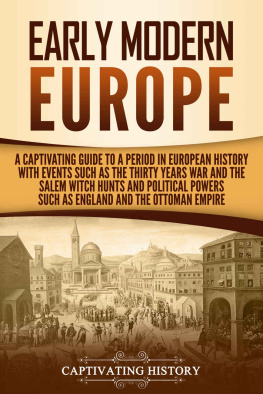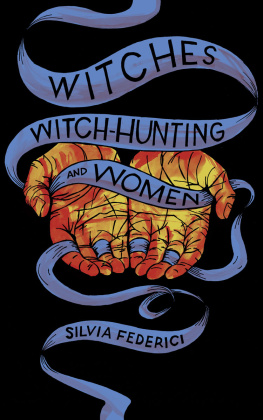ROWMAN & LITTLEFIELD PUBLISHERS, INC.
Published in the United States of America
by Rowman & Littlefield Publishers, Inc.
A wholly owned subsidiary of The Rowman & Littlefield Publishing Group, Inc.
4501 Forbes Boulevard, Suite 200, Lanham, Maryland 20706
www.rowmanlittlefield.com
Estover Road
Plymouth PL6 7PY
United Kingdom
Copyright 2007 by Rowman & Littlefield Publishers, Inc.
All rights reserved. No part of this publication may be reproduced,
stored in a retrieval system, or transmitted in any form or by any
means, electronic, mechanical, photocopying, recording, or otherwise,
without the prior permission of the publisher.
British Library Cataloguing in Publication Information Available
Library of Congress Cataloging-in-Publication Data
Jensen, Gary F.
The path of the Devil : early modern witch hunts / Gary Jensen.
p. cm.
Includes bibliographical references and index.
9781461645092
1. WitchcraftHistory. I. Title.
BF1566.J46 2007
133.4309dc22
2006002136
Printed in the United States of America
 The paper used in this publication meets the minimum requirements of American National Standard for Information SciencesPermanence of Paper for Printed Library Materials, ANSI/NISO Z39.48-1992.
The paper used in this publication meets the minimum requirements of American National Standard for Information SciencesPermanence of Paper for Printed Library Materials, ANSI/NISO Z39.48-1992.

Preface
One of the most popular books assigned as supplemental reading in introductory sociology, deviance, and theory courses in sociology in the 1970s and 1980s was Kai Eriksons (1966) classic, The Wayward Puritans. Eriksons work dealt with three waves of ritualistic punishment in New England, including the Salem witch trials, and is the best known of a relatively small number of works by sociologists dealing with issues relevant to the larger episode referred to by most historians as the early modern witch craze. Additional sociological treatments of the topic can be found in a small set of articles (Currie 1968; Chambliss 1976; Ben-Yehuda 1981; Andreski 1982; Sebald 1981, 1989; Goode and Ben-Yehuda 1994b), a chapter in a larger work (Stark 2003), and a few monographs (Sebald 1978; Weisman 1984; Ben-Yehuda 1985; Andreski 1989; Oplinger 1990; Goode and Ben-Yehuda 1994a; Geis and Bunn 1997).
In contrast, theory and research on the topic by historians has been growing at a rapid pace, with over twice as many books on the topic published in the 1990s alone than the total for sociology in the forty years since Eriksons work was published. The study of the witch craze has become a major specialty among historians, but comparatively little has been published on the topic by sociologists. This neglect may reflect the fact that sociology has become a highly specialized discipline, and the phenomena of interest fall between the cracks. The episodes encompassed have some of the features of collective behavior and social conflict , but involved institutional mechanisms that locate it in the specialty involving law and social control. And, when the discussion turns to the social construction of the stereotypical witch, the punishment of women as witches, variations in witchcraft, and possession, then it falls within the study of deviance.
This study of The Path of the Devil demonstrates that the early modern witch craze is an ideal topic for illustrating (1) the different features of the historical episode that are highlighted when different sociological concepts are applied (e.g., deviance, social control, collective behavior, social conflict), (2) the application of different types of sociological theories (e.g., functionalist vs. conflict theories), (3) the issues involved when scholars move toward greater precision and begin to operationalize variables, and (4) the issues that can be addressed through the compilation of quantitative data and statistical analysis. These are topics that are relevant to basic introductory courses in sociology and a wide variety of advanced courses.
The monograph is intended to illustrate the utility of bridging work in often insular academic specialties within sociology as well as across disciplines. The specialists within sociology that should have some interest in the work include scholars and teachers covering womens studies, gender, theory, deviance, law and social control, contentious politics, social conflict, medical sociology, collective behavior, social change, minority groups, and religion (among others). The range of topics addressed in the book should give the work interdisciplinary appeal as should the fact that it draws heavily on the large body of literature mentioned.
Chapter 6 attempts the most far-reaching integration of disciplines and specialties by integrating historical observations with psychological perspectives on scapegoating, ideas borrowed from criminology, and themes under development in the study of collective behavior as contentious politics. The chapter builds on Charles Tillys proposition that forms of social conflict vary among social settings to explain societal and temporal variations in witch hunts with specific attention to the relationships among war, rebellion and witch hunts.
The Path of the Devil has some of the properties of a scientific monograph because it incorporates the results of a project funded by the National Science Foundation (Temporal and Spatial Variations in Early Modern Witch Hunts, 1993-94). Indeed, a major emphasis in the work is that a casual inspection of general trends cannot untangle complicated relationships, and that some specific empirical issues necessitate a multivariate analysis. Most of the statistical detail is confined to two chapters and, when provided, is not unduly complex. Some data are presented in chapters 6 and 7, but in a fashion that should be within the grasp of most readers and certainly college students.
Chapter 7, The Salem Witch Hunt: A Perfect Storm, focuses on the witch hunt of particular interest to students in the United States. New theories about the timing of the Salem episode have been proposed in recent years, one deemed to be meticulously researched, attributing the episode to sleeping sickness. Moreover, a sizeable number of students are familiar with the argument that the Salem craze was linked to ingestion of a type of mold (ergot) that grows on rye and can cause hallucinations. Although information that has a scientific aura is presented to back such biological arguments, no actual systematic analysis is presented in either case. When data cited as support for these two biomedical theories are compiled and analyzed in chapter 7, neither fares very well. In contrast, most features of the Salem witch hunt are quite consistent with the general sociohistorical observations arrived at in the study of the European witch craze. In fact, the title for the chapter reflects the fact that the generalizations and observations presented in earlier chapters can be illustrated using information about the Salem-Essex County trials. A perfect storm occurs when a variety of circumstances converge to generate an unusually dramatic event.
The final chapter deals with questions that are raised by most audiences to any discussion of witch hunts: Was McCarthyism an instance of the same phenomenon in more modern times but in a different form? Are there any parallels between the search for witches and Satanists in preschools and the early modern witch hunts, including Salem? Are attacks on women as witches still occurring in modern times? Metaphorical comparisons are commonly proposed when considering modern versions of witch hunts, but it is intriguing to ask whether any evidence would point to any of these modern episodes as more than a metaphor. In short, is there any evidence that empirically discerned relationships found in the study of the early modern witch hunts apply to modern witch hunts?














 The paper used in this publication meets the minimum requirements of American National Standard for Information SciencesPermanence of Paper for Printed Library Materials, ANSI/NISO Z39.48-1992.
The paper used in this publication meets the minimum requirements of American National Standard for Information SciencesPermanence of Paper for Printed Library Materials, ANSI/NISO Z39.48-1992.